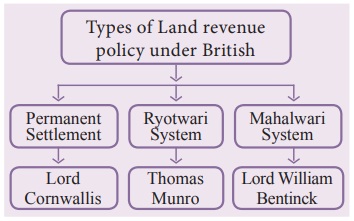Rural Life and Society | Chapter 3 | History | 8th Social Science - The Land Revenue Policy under the British | 8th Social Science : History : Chapter 3 : Rural Life and Society
Chapter: 8th Social Science : History : Chapter 3 : Rural Life and Society
The Land Revenue Policy under the British
The Land Revenue Policy under the
British

Permanent Settlement
When Robert Clive obtained the
Diwani of Bengal, Bihar and Orissa in 1765, there used to be an annual
settlement (of land revenue). Warren Hastings changed it from annual to
quinquennial (five- yearly) and back to annual again. During the time of
Cornwallis, a ten years’ (decennial) settlement was introduced in 1793 and it
was known Permanent Settlement.

Permanent settlement were made in
Bengal, Bihar, Orissa, Varanasi division of U.P., and Northern Karnataka, which
roughly covered 19 percent of the total area of British India. It was known by
different names like Zamindari, Jagirdari, Malguzari and Biswedari.
Salient Features of the Permanent
Settlement
* The Zamindars were recognised as the
owners of land as long as they paid the revenue to the East India Company
regularly.
* The Zamindars acted as the agent
of the Government for the collection of revenue from the cultivators.
* The amount of revenue that the
Zamindars had to pay to the Company was firmly fixed and would not be raised
under any circumstances.
* They gave 10/11 of the revenue
collected by them from the cultivator to the Government.
* The Zamindars would grant patta
(written agreements) to the ryots. The ryots became tenants since they were
considered the tillers of the soil.
* All judicial powers were taken
away from the Zamindars.
Merits
* Under this system many of the
waste lands and forests became cultivable lands.
* The Zamindars became the owner of
the land.
* The Zamindars were made free from
the responsibility of providing justice.
* The Zamindars remained faithful to
the British Government.
* This system secured a fixed and
stable income for the British Government.
Demerits
*
The British Government had no direct contact with the cultivators.
*
The rights of the cultivators were ignored and they were left at the mercy of
the Zamindars.
* The peasants were almost treated
as serfs.
*
This system was made the Zamindars lethargic and luxurious.
*
Many conflicts between the Zamindars and the peasants arose in rural Bengal.
Ryotwari
system
Ryotwari
system was introduced by Thomas Munro and Captain Read in 1820. Major areas of
introduction of Ryotwari system included Madras, Bombay, parts of Assam, and
Coorg provinces of British India. By Ryotwari system the rights of ownership
was handed over to the peasants. British government collected taxes directly
from the peasants. Initially, one-half of the estimated produce was fixed as
rent. This assessment was reduced to one -third of the produce by Thomas Munro.
The revenue was based on the basis of the soil and the nature of the crop.

Rents would be periodically revised,
generally after 20 to 30 years. The position of the cultivators became more
secure. In this system the settlement was made between the Government and the
Ryots. Infact, the Government later claimed that the land revenue was rent and
not a tax.
Salient Features of the Ryotwari
system
* Revenue settlement was done
directly with the ryots.
* Measurement of field and an estimate of
produce was calculated.
*
Government fixed the demand at 45% to 55% of the produce.
Effects of
the Ryotwari Settlement
* In most areas the land revenue
fixed was excessive; the ryots were hardly left with bare maintenance even in
the best of seasons.
*
Under this system the government exploited the farmers instead of Zamindars.
Mahalwari
system
Mahalwari
system, a brain child of Holt Mackenzie was modified version of the Zamindari
settlement introduced in the Ganga valley, the North-West Province, parts of
the Central India and Punjab in 1822. Lord William Bentinck was to suggest
radical changes in the Mahalwari system by the guidance of Robert Martins Bird
in 1833. Assessment of revenue was to be made on the basis of the produce of a
Mahal or village. All the proprietors of a Mahal were severally and jointly
responsible for the payment of revenue. Initially the state share was fixed
two-thirds of the gross produce. Bentinck, therefore, reduced to fifty percent.
The village as a whole, through its headman or Lambardar, was required to pay
the revenue. This system was first adopted in Agra and Awadh, and later
extended to other parts of the United Provinces. The burden of all this heavy
taxation finally fell on the cultivators.

Salient
Features of the Mahalwari Settlement
* The Lambardar acted as intermediaries
between the Government and the villagers.
* It was a village-wise assessment.
One person could hold a number of villages.
* The village community was the
owner of the village common land.
* The village land belonged to the village
community.
Effects of the Mahalwari Settlement
* The Lambardar enjoyed privileges
which was misused for their self-interest.
* This system brought no benefit to the
cultivators.
* It was a modified version of the
Zamindari system and benefited the upper class in villages.
Impact of the British land revenue system on
the cultivators
* A common feature of all the
settlements was the assessment and the maximize income from land. It resulted
in increasing land sales and dispossession.
*
The peasants were overburdened with taxation. Due to the tax burden and
famines, in general, the people suffered in poverty and burdened with debts.
They had to seek the moneylenders who became rich and acquired lands from the
peasants.
* The Zamindars, money-lenders and
lawyers exploited the poor peasants.
* The stability and continuity of
the Indian villages was shaken.
* Cottage industries disappeared on
account of the import of British goods and the peasants had nothing to
supplement their income.
* The old body of custom was
replaced by new apparatus of law, courts, fees, lawyers and formal procedures.
*
The British policy proved advantageous only to the government of a privileged section
of the society at the cost of the cultivators who were the rightful owners of
their lands and claimants of the larger share of the produce.
Related Topics